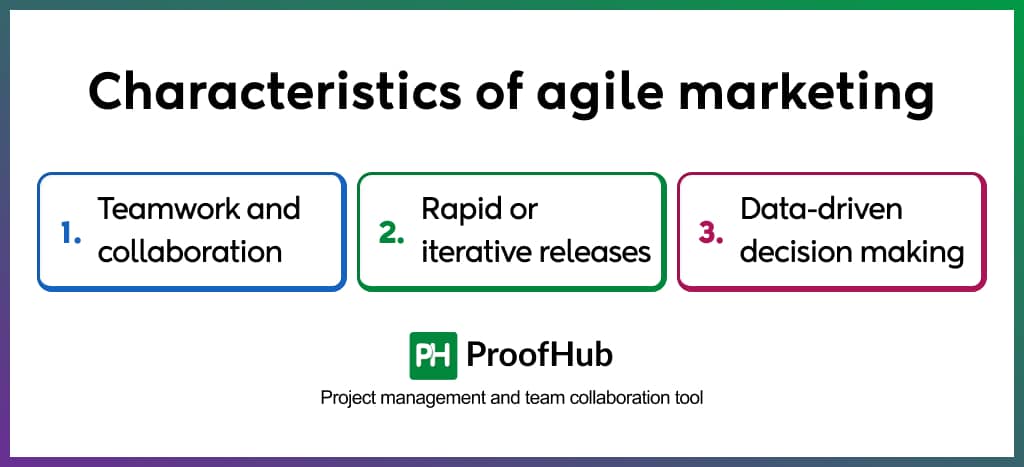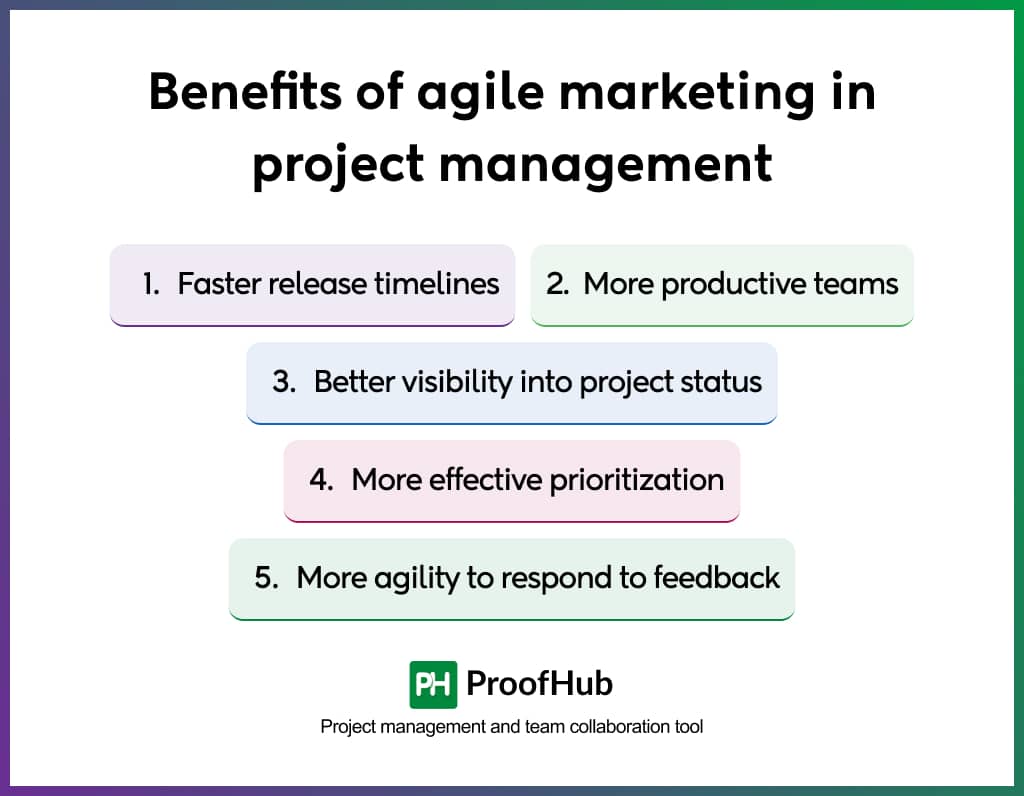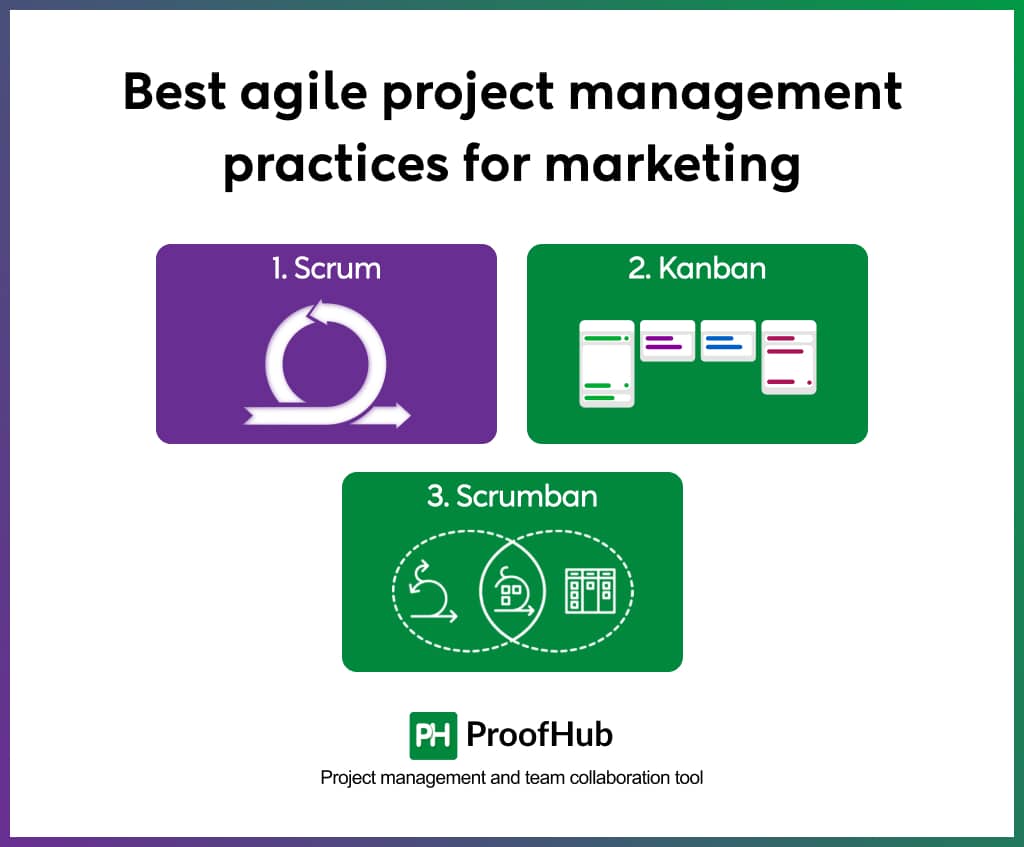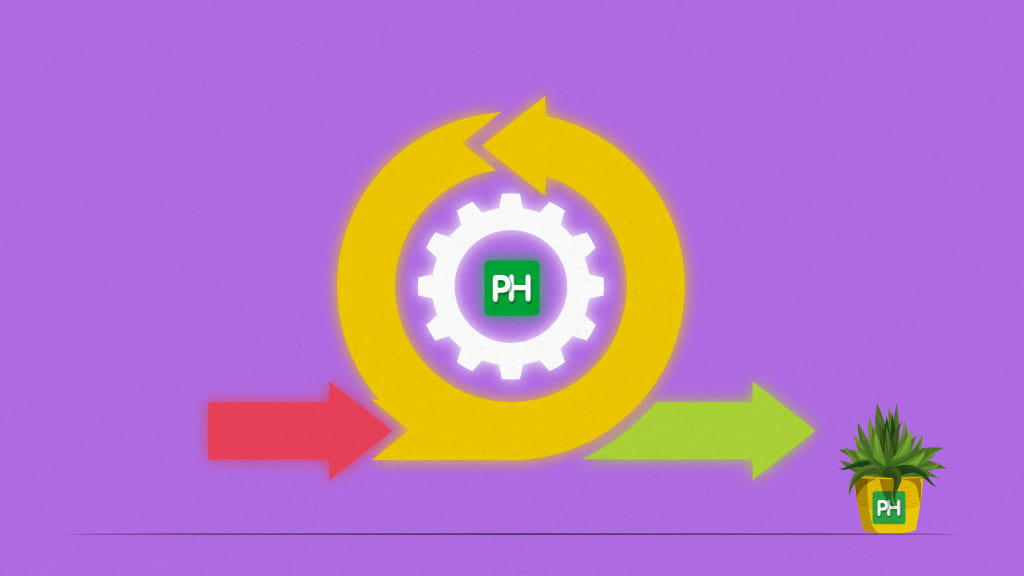We know that there are many advantages of Agile project management. Teams can operate more effectively and efficiently while providing the highest-quality product within the limits of the budget with the help of agile approaches.
Agile methodologies helped to transform the way businesses used to function. Agile promotes success for software teams by segmenting work into manageable chunks, getting ongoing feedback, and allowing for flexibility to respond to changes.
This strategy has proved so effective that fields other than software have also started incorporating agile methods into their workflows. One such example is the Marketing field.
93% of CMOs who employ Agile practices say their speed to market for ideas, campaigns, and products has improved.📈
Thus, Agile project management for marketing is one of the best ways to take your marketing projects to the next level.
What is agile marketing?
Agile marketing is the application of Agile project management methods to marketing projects.
It is a relatively new method of managing marketing projects that makes use of agile software development principles. This comprises:
- Small, self-organizing, cross-functional teams
- Deliver a project in frequent iterations called sprints
- And continuously review and update processes based on feedback
Characteristics of agile marketing

There are three important characteristics of every successful agile marketing:
Teamwork and collaboration
The foundation of agile marketing starts with teams that embrace agile ways of working. Agile marketing involves a lot of free and efficient team collaboration. It helps in replacing work silos and hierarchies. It involves every team member in some or other part of the project.
Rapid or iterative releases
Sprints, which are short periods when a scrum team works to complete a predetermined amount of work, are frequently used by agile marketing teams. Teams can complete lesser amounts of work within a sprint while still producing iterative work releases thanks to the sprint cycle. Sprints provide you the chance to alter your course of action every few weeks because they are brief.
Data-driven decision making
Agile marketers approach marketing initiatives using data. Teams that value agility is motivated by data, in fact all contemporary marketers rely on it to some level. Agile marketers continually come up with new experiments to improve the effectiveness of the team and rely on data to gauge and tweak their performance.
Wish to streamline your agile marketing processes without breaking sweat? Sign up for ProofHub now!
What is agile project management for marketing?
Agile project management for marketing is an approach that’s designed to make teams more receptive to input and external changes. It’s a customer-centric, adaptable, iterative approach to project planning and execution that emphasizes continual improvement.
Agile project management is currently living up to its marketing hype. According to AgileSherpas’ third annual State of Agile Marketing Report, 42% of the 637 marketers surveyed admitted to employing at least some aspects of the Agile method to project management. Additionally, this was the first time in the report that more marketers described themselves as Agile practitioners than ad hoc or traditional marketers.
Agile project management for marketing is probably a strategy that is here to stay. One explanation for this is that it makes it possible for businesses to quickly adapt to emerging trends and communicate ideas to the public. Chief marketing officers are particularly interested in its advantages.
Benefits of agile marketing in project management

1. Faster release timelines
Speed is one of the biggest benefits of agile marketing. With the analysis of data, increase productivity by allocating projects to the right person in order to reach maximum productivity. 93% of CMOs believe Agile practices say their speed to market for ideas, campaigns, and products has improved.
2. More productive teams
Agile Marketing executes marketing plans instead of grouping individuals by their function, agile organizations prefer small, cross-functional teams that are capable of finishing projects autonomously with few handoffs between teams. A joint report from AgileSherpas and Aprimo states, 53% of Agile marketing teams achieve faster time to get things released.
3. Better visibility into project status
Instead of keeping everything in a large spreadsheet or hidden on a hard drive, visualization boosts collaboration between individuals and teams inside the marketing department. To help you enjoy process transparency, tools like Kanban board and frequent synchronization meetings like the daily standup. This facilitates transparency and ensures better visibility to project status. 46% of Agile marketers say better visibility is the most common benefit (AgileSherpas/Aprimo).
4. More effective prioritization
By allocating projects and seeing how much is needed for each one helps prioritize projects that may take longer or require more resources than others. Data from this strategy helps distribute the work to maximize high-priority projects. In another report, 56% of marketers indicated managing shifting priorities as their top challenge.
5. More agility to respond to feedback
According to the 2020 State of Agile Marketing Report, 53% of Agile marketing teams can release things faster, and 51% can change gears quickly when feedback demands it. Project management teams are able to shift gears based on feedback
Best agile project management practices for marketing

The three most common agile marketing frameworks used by marketers are kanban, scrum, and scrumban (a hybrid between the two).
- Scrum
Scrum was the first agile software development approach. Through the use of timeboxing, it fosters a culture of openness, scrutiny, adaptation, and laser-focus on a portion of the team’s highest-priority task. Ceremonies (events) and roles are the two fundamental parts of Scrum.
The agile marketing team uses Scrum’s four ceremonies to establish a regular, predictable cadence for many forms of communication, including:
- Sprint planning
- Daily scrum (also known as daily standup)
- Sprint review
- Sprint retrospective
In any scrum deployment, maintaining the process and backlog are crucial duties for the scrum master and marketing owner, respectively. The team lead typically serves as both the scrum master and marketing owner in scrum marketing teams.
- Kanban
Kanban is another agile framework that was introduced as a method of process management for knowledge work.
Kanban quickly caught the attention of marketers because of its visual style and emphasis on continual development (kaizen). Marketing teams must visualize each step of the marketing process as well as each work item that moves through it in order to use Kanban. By limiting the number of tasks they take on and managing their workflow, marketing teams can work more effectively.
The kanban method has six core practices:
- Visualize workflows
- Limit work-in-progress
- Manage flow
- Make process policies explicit
- Establish feedback loops
- Continuous improvement
Kanban’s central paradox is that by restricting the quantity of work completed (at once), the team becomes more productive, which may seem paradoxical to newly created agile teams.
Read More-: Kanban vs Agile: An in-depth comparison of two popular frameworks
- Scrumban
This is Agile marketing’s most well-liked hybrid strategy. It represents a versatile fusion of kanban and scrum methodologies. The approach is very adaptable and may resemble either of the two pure frameworks more or less, depending on your tastes and organizational environment.
Scrumban is appropriate for teams with some prior experience using agile. Understanding scrum and kanban ceremonies, roles, and processes are beneficial for this approach.
At its foundation, scrumban combines the pull-based characteristics of kanban with some of the structural elements of scrum. Due to the hybrid nature of the technique, each team usually uses scrumban a little bit differently.
Get started with agile marketing using ProofHub
ProofHub is an all-in-one Agile project management software used by more than 85,000 organizations all over the globe. It comes packed with all the agile features that your marketing team needs to plan, collaborate, and organize work.
Teams can effortlessly share ideas, compile documents, start discussions and move forward with this collaborative tool. The software combines the benefits of both traditional project management style and Agile methodologies—and provides those benefits to growing teams and businesses under one roof.
Here’s how ProofHub can help in Agile project management for marketing:
- Effective goal setting and work tracking
If you’re into marketing, you know that no marketing team in this world can function well with proper planning and efficient goal setting. Marketing planning defines the role and responsibilities of marketing executives in such a way as to achieve the goals of the firm.
It helps you allocate your marketing resources in the best and most economical way. ProofHub helps you define roles and responsibilities effectively so that everyone knows exactly what they are supposed to do. It also allows you to allocate tasks to your team members and further divide the work into sub-tasks for better ideas.
You can organize your work according to your requirements in different project views in ProofHub like Gantt charts, Table view, Board view, and more. These project views provide you with a clear idea of which stage your tasks are in, what are the bottlenecks, who is working on what, and what changes you need to make.
- Efficient team communication and collaboration
ProofHub provides you robust team collaboration and communications features so that you can easily connect with your marketing team in no time and work together efficiently.
ProofHub Discussions help you bring your team and client discussions in one place. While working on different projects, teams can create specific discussion topics that focus on a particular matter and have brainstorming sessions in real-time.
The in-built chat application in ProofHub allows you to send direct and instant messages to your team members quickly. You can either have one-on-one chat or communicate with your entire team at one go using the group chat feature.
The Notes section helps you jot down important information related to your projects in different notebooks and share them with your team members so that nobody misses out on essential stuff and nothing falls through the cracks.
Bring all your team members together and collaborate efficiently in one place. Give ProofHub a try!
- Work in iterations or sprints
Planning and managing iterations or sprints is the most crucial task you must complete in agile marketing. How you oversee work progress and manage project workflows will have a big impact on how successful your team and projects are.
When adopting the agile technique to manage marketing projects, Kanban boards are incredibly useful. By utilizing the effectiveness of Kanban boards, marketing teams may also make the transition to Agile marketing more easily.
Here’s what your Agile marketing team can do by using ProofHub’s Kanban board view:
- Divide your marketing projects into different tasks and subtasks
- Create multiple stages of your marketing workflow
- Check how tasks move through each stage
- Select assignees for each task
- Set the start and finish dates of tasks
- Add comments and files as attachments to tasks.
- Real-time monitoring of task and project progress
- Real-time progress measuring
For easy project progress analysis, ProofHub offers you detailed custom reports for each team member or the entire project.
It enables you to see each detail of your project as well as the general development in one location.
A thorough burn-up chart allows you to rapidly compare the quantity of work accomplished to the total work. Not only that, but you may also determine how quickly things have been completed.
The team members can improve their individual performance with the help of the time tracking feature. It also helps you to evaluate the productivity of your team members and measure the overall number of working hours. It offers you transparency and visibility and enables effective resource management.
All of your time data is collected in one location using ProofHub’s time tracker. You can set time estimates and add timesheets. Even better, you may use an automatic timer or even keep track of time manually.
Also, the activity tracker in ProofHub provides insight into all the changes and updates being made in the projects. It notifies you about every little activity done by a team member.
Conclusion
We hope that by now you have a clear understanding of what Agile marketing really is.
Long story short, It’s the best and newest way to supercharge your marketing efforts.
By using the Agile marketing methodology, you’ll be able to get the best out of your marketing campaigns.
However, you can’t do this without the right technology.
You’ll need a sophisticated Agile marketing tool like ProofHub to help you plan and execute Agile projects with ease.
From Kanban boards and collaboration tools to Project reports, it’s got everything your team needs to go Agile.
FAQ:
Can agile be used in marketing?
Agile marketing can be used in marketing as it is an approach to marketing that utilizes principles from agile methodologies to create a more iterative process for marketers.
How Agile methodology is used in marketing?
Marketers can use agile methodology in Scrum, when work is broken up into sprints and Kanban project management to limit the number of tasks to maximize throughput.

